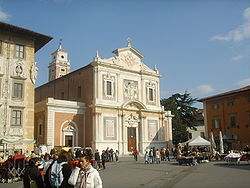This article needs additional citations for verification .(December 2012) |
| Church of Santo Stefano dei Cavalieri | |
|---|---|
 | |
| Religion | |
| Affiliation | Roman Catholic |
| Location | |
| Location | Pisa, Italy |
 | |
| Coordinates | 43°43′09.57″N10°24′03.43″E / 43.7193250°N 10.4009528°E |
| Architecture | |
| Architects | Giorgio Vasari, Pasquale Poccianti, Gaetano Niccoli |
| Type | Church |
| Style | Mannerism |
| Groundbreaking | 1565 |
| Completed | 1859 |

Santo Stefano dei Cavalieri is a church in central Pisa, located on Piazza dei Cavalieri (Knights' Square). [1]
Contents
Construction began on 17 April 1565 to provide a place of worship for the Order of Knights of St Stephen, founded by Grand Duke Cosimo I de' Medici to combat Saracen piracy in the Mediterranean. The site was previously occupied by the church of San Sebastiano alle Fabbriche Maggiori, which dated back to at least 1074. The new church was consecrated on 21 December 1569. Its white marble façade was designed by Don Giovanni de' Medici, with help from Alessandro Pieroni, and replaced Vasari’s original design. An inscription commemorates its completion during the reign of Ferdinando I de' Medici.
The bell tower, designed by Vasari, was completed in 1572 by Giovanni Fancelli. The main altar was designed by Pier Francesco Silvani. Over two centuries, several alterations were proposed by architects such as Gherardo Mechini, Paolo Guidotti, Ranieri Gherardi, Torpè Donati, Alessandro Gherardesca, Florido Galli, Niccolò Matas, and Pasquale Poccianti. The final reconstruction in 1859, after the suppression of the order, created the orderly interior column layout seen today.





